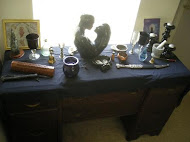Halloween
This is an excerpt from The Element Encyclopedia of Witchcraft
Also known as All Hallows, All Hallowmas, All Saints' Day, Hallowtide, and November Eve.
No night is more identified with witchcraft, magic, spirits, and ghosts. This is the night when the veil between realms is so thin as to be nonexistent. It is thus the perfect night for divination, magical ritual and spells, petitions to spirits and communication with the dead. The Wild Hunt rides on Halloween and the fairy mounds open up. This is one of the few nights when the trooping of the fairy folk is visible and changelings can be rescued.
"Hallow" derives from an Old English word for "holy." Until the early sixteenth century, the word was usually applied only to saints and so it is essentially an archaic word for "saint." All Hallows Eve is the vigil preceding All Saints' Day, the Roman Catholic festival corresponding to ancient feasts of the dead. "Hallow" however has since gained the meaning of "holy" or "sacred," as in "hallowed ground," so Halloween may also be understood as "Sacred" or "Holy Night" - which for witches and those who love them, it is. (Those who fear them, on the other hand, would say that this is a night for staying inside because witches, demons, ghosts and fairies are at the height of their powers!)
The Feast of All Hallows is thus synonymous with the Feast of All Saints. All Hallows' Even became Hallowe'en which eventually became Halloween when the apostrophe was lost sometime during the mid-twentieth century.
In some areas (particularly those where witches are most active on May Eve or Midsummer's) the Feast of All Saints is a serious, solemn, devout festival completely devoted to Christian prayer. In other areas, historically in Ireland and the British Isles, Halloween retained it anarchic associations with witchcraft festivities and as such is a holiday devoted to fun, pranks, magic, and divination, to varying degrees, depending upon individual orientation. Maybe some witches still fly off on their broomsticks to deserted mountain peaks. Others attend Halloween parties, witches' balls, and dumb suppers. It is a sacred night for witches, the perfect moment for spells, rituals, and devotions to the spirits. For others, it's the night to dress up as witches and go out and revel in the spirit of fun and freedom that witches allegedly always enjoy.
Halloween is a time for making wishes and for rituals to obtain good fortune.
This entire ritual, from the moment you leave your home until the handkerchief filled with graveyard dust is safely hidden, must be done in complete silence. Not a peep or your wishes allegedly won't come true!
- Purchase a new cotton handkerchief before Halloween begins. Don't use it; keep it clean and reserve it for the following ritual.
- As early as possible on November 1st, as early as one minute past midnight, leave home, taking the handkerchief, and go to a cemetery, entering by the main gate.
- Walk along the path to the wall opposite the main gate. At some point on this walk, pick up a little dirt, put it in a corner of the handkerchief and make a wish while knotting that corner shut.
- Retrace your steps exactly (or even walk backwards!) out the main gate.
- Go to a second cemetery, repeating stops 2, 3, and 4, knotting the pinch of dirt up in a different corner of the hanky.
- Go to a third cemetery and again repeat steps 2, 3, and 4. At this point you will have gathered three pinches of dirt and formed three knots in the handkerchief.
- Go home and hide your handkerchief on a high shelf or within the rafters or somewhere where it won't be disturbed. Your wishes will allegedly come true.
Halloween is a complex festival with many roots. In its present form it is an amalgamation of the Celtic festival Samhain with the Roman celebration of Pomona, the spirit of crops, fruit, nuts, and seeds, and with assorted other Pagan festivals of the dead, including those devoted to the Corn Mother, as well as of magic powers and women's "witch power." It is no accident that Halloween (and many festivals of the dead) fall within the zodiac sign of Scorpio, which has dominion over reproduction, the mysteries of sex, and the portals of birth and death.
Pomona, the Apple Queen, was the Roman deity of fresh fruit and fruit trees, especially apples. Her name derives from the Latin pomum. similar to the French word pomme or "apple." Pomona was a wood-nymph whose attribute is a pruning knife. (The Romans were responsible for domesticating wild apples, transforming the sour fruit into the juicy, delicious one of today.) The beautiful Pomona was sought after by many, including the goat-god Pan, but rejected them all, preferring to remain independent. She was finally wooed and won by Vertumnus, the male deity of the shifting seasons, who became her consort. Vertumnus represents the year in its guise as shape-shifter. Pomona initially rejected him too, until he gained her trust by approaching her in the form of an old woman - a classic bit of ancient Halloween masquerading.
Halloween also falls within the period when the dead are understood to return to their old haunts. Traditionally at Halloween, children costumed as spirits of the dead or ghosts went begging from door to door, where they were given the seeds of life in the form of nuts and fruits, especially apples and hazelnuts.
Recently Halloween has become characterized by the grotesque and gross in the same manner that once suspenseful "horror" films have been replaced by gore. In Victorian days, Halloween was a romantic holiday to rival St Valentine's Day. (Both days may derive form similar roots; see Lupercalia, page 209.) Halloween cards were given to one's beloved in the way that one may now receive a Valentine's card. (Cards were frequently decorated with images of witches, more often beautiful and seductive than grotesque.) It is also the perfect night to engage in romantic divination and love magic.
Halloween is traditionally a time for games and fortune-telling. Many techniques are reserved for this night alone:
- A Simple Halloween Divination: Go to a crossroads on Halloween and make an invocation to the deity, angel or ancestor of your choice. Listen to the wind or any words you hear at midnight (e.g, passing car radio or human voices) to hear your oracle for the next year.
Dumb Suppers
"Dumb suppers" earned their name because the entire ritual is conducted in silence from start to finish. No matter what happens or who shows up for dinner, it is vital to remain silent and to reserve discussion for after it is very clear that the ritual is over. Traditionally, dumb suppers serve either of two purposes:
- Romantic divination - dumb suppers serve as divinatory methods of discovering your true love or your destined spouse (ideally but not always one and the same!) When you prepare the dumb supper, set the table for two. Allegedly your other half will come and dine with you. (This is not necessarily meant literally; expecting immediate literal results from magic spells leads to disappointment. Spells can "come true" in various magical ways.)
- Necromancy - the dumb supper serves as a type of s`eance. It may derive from rituals similar to those of the Dias de los Muertos celebrations where the living dine with the souls of the deceased.
There are all sorts of variations on the Dumb Supper. Here are two:
- Dumb Supper One: Starting at the stroke of midnight, set the table while consistently walking backwards, so that there are nine things on the table to eat. (Things like salt and pepper or butter count among the nine.) Then silently honor those who have passed on.
- Dumb Supper Two: Set the table for two or more as desired. Each living person gets a plate; a setting is also laid for each anticipated invisible guest. Do not expect them to serve themselves. If this is a group dinner, guests are invited to bring photos or images to represent the souls of the deceased to whom invitations have been extended.
- Leave all the doors and windows unlocked. (If possible, leave them open, although depending on where you are, nights at this time of year can be very chilly.)
- Reverse the supper. Set the table in reverse; serve the food in reverse order, beginning with coffee, tea and dessert and working backwards.
Halloween Trees:
Ancient traditions re-emerge in surprising new ways. The vestiges of "tree-worship" that have survived for so many centuries as Christmas trees, Yule logs, Maypoles and Easter egg trees have been joined in very recent years by a brand new tradition: the Halloween tree.
Similar to those other holiday "trees" named above, Halloween trees are lovingly decorated with charms and ornaments inspired by the holiday and by witchcraft. Many ornaments for instance are crafted in the image of witches or their accouterments.
Unique and very appropriate to this holiday, however, before being decorated, Halloween trees are completely bare. Halloween trees are either deciduous trees that have dropped all their leaves or are in fact dead trees, perhaps the equivalent of ghost trees. Sometimes miniature Halloween trees are crafted from black wrought iron or other metals.
Samhain
Pronounced "Sow'en." Corresponds in time to Halloween.
Samhain translates prosaically as "summer's end." It marks the end of the light half of the Celtic year and the beginning of the dark half. The border between years is distinguished by the lack of the border between worlds.
- The notion of the year being split into dark and bright halves isn't limited to Celtic areas. In Russia, for instance, the dark half of the year belongs to the spirits. It's the perfect time for story-telling, magic, and divination, culminating with May Day.
The Celtic New Year begins at nightfall on October 31st - the beginning of the Gaulish month Samonios, the first month of the year. The veil between realms may be penetrated. Barrow wights, ghosts, fairies, and other spirits roam through the night. According to Irish tradition, the barrows and mounds where the fairies dwell open up on Samhain so that the fairies can come out to revel. And so, what kind of spirit-working witch would wish to stay home, at least unless she was occupied by rituals there?
Although modern Halloween celebrations and Neo-Pagan Samhain are based largely upon traditions of Ireland and Britain, there is no reason not to think that similar commemorations didn't exist throughout Celtic-influenced Europe, if only because the Church felt it important enough to create the Feast of All Saints to substitute for these concurrent festivals of the dead. It is a Breton custom to pour libations over grave stones and tombs at this time.
Metaphysics aside, Samhain was also an ancient Celtic pastoral festivity. It signaled the end of the grazing season, when only breeding stock was set aside from the end-of-the-year slaughter. The harvest was brought in at this time. There is an Irish superstition that crops left out after November 1st would be spoiled by the fairies. (Although perhaps this camouflages an older belief that crops left out after November 1st belonged to the fairies and were no longer safe to be touched.)
This may have been a time of sacrifice for the Irish Druids. Some suggest that human sacrifice may once have occurred at this time but there's no way of currently knowing whether that was ever true or whether that information is based on attempts to defame and discredit the Druids. Horses were also once allegedly sacrificed.
According to legend, the Irish deities the Dagda and the Morrigan consummate their relationship today and ensure the fertility of land, people and animals for the year to come. The Dagda, "the good god" is the tribal father god; the Morrigan, "the phantom queen," is often described as a "battle goddess" although that only hints at her powers. She begins the Great Rite in the form of an old hag but is rejuvenated by the union, regaining her youth and beauty.
A false suggestion is frequently made that the holiday is named in honor of a deity named Samhain. There is no such deity, however a French statuette identifies Cernunos, the horned Celtic deity with the Roman deity Dis, Lord of the Underworld. It's possible that he was worshipped at Samhain.
Disclaimer: No one involved in this blog or its contents may be held responsible for any adverse reactions arising from following any of the instructions/recipes on this list. It is the reader's personal responsibility to exercise all precautions and use his or her own discretion if following any instructions or advice from this blog.















No comments:
Post a Comment